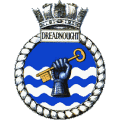Gentlemen,
Thanks for your friendly comments. However: don't be fooled by the fact that I clean up the surface I take the pictures on. As well, when moving from hotel to hotel, you hardly have any chance to really mess up.
Another 2 weeks have passed and again I am sitting in a Chinese hotel in front of my improvised workbench. Again, the little spare time I have left is filled with model building ass far as conditions allow.
Before leaving Germany I tried to plan ahead a bit and found that taking care of the funnel would be one of the next things to come up. Since it would be impractical to start extensive drilling in a hotel room, I started initial steps the night before my departure.
When you look at the funnel part it becomes clear quite quickly, that it can not be used like that on a detailed build. Again HP model tries to fulfil the requirements on the OOB builder simulating a solid cast funnel grill. Certainly that would have to go. As, well everybody knows that a hollow funnel adds greatly to the depth of every build.

To hollow out the funnel I planned to use my Proxxon drill (similar to Dremel) with a vertical holder.

First I made sure that the bottom of the funnel parts was nice and plain so that the drill would enter perfectly vertical. Upon the inspection I found that the funnel collar was chipped in two places. Comparing with photos of the real vessel I found that this collar was much too pronounced anyway, so it had to go. I removed it by chipping away with my Olfa knife. Then I cut off the funnel grill and sanded the top of the funnel flat. I made sure the top rim of the funnel would be parallel to the bottom. Having prepared the part this far, I drilled some 20 holes about 25mm deep into the funnel using a 1,2mm new and sharp steel drill bit. As the resin of this kit is not very brittle and may be carved nicely, I was able to use the drill bit as a milling cutter. With careful circular movements I made the holes bigger and connected the individual drill holes into one big hole. By continuing this method I thinned down the funnel wall down to about 1 to 0.6mm. Beyond this point I did not dare to thin it in fear of breakage. I smoothed the surface over using a rotary sanding bit. The whole process took more than 90 minutes of permanent milling. I was surprised, how well that went, but I was dumbfounded by the time I was finished and looked at the clock.
Now it was time to give the innards of the funnel some thought. There seems to be no clear detail shot and no plan information for this within my references. Now this would allow for some artistic license as long as you don’t go overboard.
The funnel serves to vent all types of exhaust from the ship, reaching from burnt fuel to steam. The steam is needed everywhere on the ship and transported into the funnel from all over the ship to vent. In some ships like the IJN Yamato these steam pipes are prominently located on the outside of the stack. On ships like Bismarck and Tirpitz you can see them sticking out of the funnel cap. On the Leipzig’s sister Nürnberg there are quite a few to be seen around the funnel, too. Almost certainly there are more inside.
In the Leipzig there are – besides the signal pipe - only two steam pipes to be seen right on the front side of the stack. I think it is safe to assume that the inside of the funnel would be stacked with pipes.
I created a 2,5mm wide ledge from 1mm styrene sheet to mount the pipes and the stack dividers and placed it 3,5mm underneath the rim. In 27 holes I placed 0,5mm brass tubing.

The outside of the stack looks nice, but need a couple of additions.
The front side Aztec stairs are actually correct in this case. Two small platforms need to be added to the front. Supports are from Lion Roar. On top goes a funnel grill from the Pocket Battleship PE-set of WEM. The backside is adorned by a 5 cm tapered brass mast I ordered from NNT a while back. I think they are made by Schatton, but I am not sure. Certainly enough, these days you can get them from BMK along with fitting yardarms. As you can see I have made two incisions (just above the rim and another one 6mm above the first) This is where the lower yardarms will go later. The third and top yardarm is so far up hat the mast is too thin for an incision.
The other bits and pieces around the back of the stack are form the spares box following two excellent pictures form AJ Press’ booklet on Leipzig and previously mentioned book by Koop and Schmolke.

Railings for these small front side platforms and a total of all-around 7 foot-rails will be added after application of the colour coats. As well, putting on the three yardarms would not make sense, as these would certainly come off in transport. That certainly is one of the down sides of hotel room modelling: You hardly get anything really finished.
I hope to find some time to continue building these next days.

























































